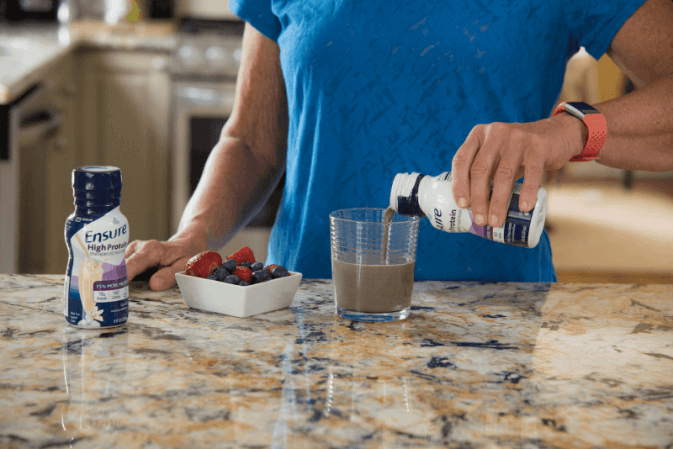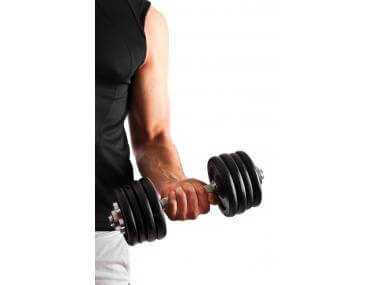5 Ways to Combat Aging Muscles
Human muscle mass begins to shrink at around age 50, so it’s important to take stock of these five ways to fight anti-muscle aging forces.
This is the third in a three-part series on muscle health that I have done in partnership with Ensure. However, the opinions I express in these articles are all my own.
We lose approximately 1% of our muscle mass each year starting at age 50. Aging muscles affect everything from our posture, to our balance, to the way we walk. Strength and endurance are reduced, and we tire more easily. Because our muscle health deteriorates progressively through time, it’s vital we take steps to combat this deterioration at middle age or younger, though it’s worth noting our muscle health can improve with a few measures even at the frailest ages.
In the first post of this series on the importance of muscle health, we reviewed the different types of muscles in our bodies and how they function, including the muscle that comprises our heart, the lining of our blood vessels, and even our urinary and reproductive systems. In the second post we reviewed the various ways the aging process takes a toll on our muscle health.
Now, let’s review five important ways we can fight these anti-muscle aging forces.
-
Moderate intensity aerobics
In 2007, after thorough research, the American College of Sports Medicine and the American Heart Association released their recommendations for appropriate physical activity for older adults. The expert panel recommends 30 minutes of “moderate-intensity” exercise at least five days a week, or 20 minutes of “vigorous-intensity” exercise three days a week.
What is meant by “moderate” and “vigorous,” exactly? Here’s how they define it:
“On a 10-point scale, where sitting is 0 and all-out effort is 10, moderate-intensity activity is a 5 or 6 and produces noticeable increases in heart rate and breathing. On the same scale, vigorous-intensity activity is a 7 or 8 and produces large increases in heart rate and breathing.”
Note that the definitions of moderate and vigorous are relatively subjective and vary with each person. While a slow walk may be vigorous for the frail and old, it would be inadequate for athletes in their prime.
It’s important to note that for those with heart or other medical conditions that may interfere with implementing a physical activity regimen, your doctor’s approval is needed prior to initiation.
-
Muscle strengthening
In addition to aerobic activity, resistance training activities that increase strength and endurance are imperative to maintaining muscle health with aging. Even for the frailest older adults living with advanced age, suffering from chronic illnesses, living in nursing homes, or stuck in extremely sedentary lifestyles, resistance training has been shown to significantly improve muscle function and strength. Progressive resistance training improved everything from chair-to-stand time, stair climbing, gait speed, and balance.
The panel recommends eight to ten different exercises (with 10-15 repetitions of each) that target major muscle groups for a minimum of two nonconsecutive days a week. Note that leg strength is often lost before arm strength, so strengthening leg muscles should be a key initial goal.
-
Flexibility and Balance
Range of motion is also diminished with aging. Therefore, exercises to increase flexibility should be performed for a minimum of ten minutes at least two days a week. And for those at risk of falls–a top cause of injury in older adults–exercise that improves balance is imperative to add to their exercise plans and can be performed three times a week.
-
Vitamin D
Vitamin D has been over-hyped in the media, claiming to aid everything from depression to cancer and everything in between. Many of those claims have not been validated with substantial evidence, but one exception pertains to the aging population at risk for falls. Studies show that vitamin D supplementation reduces the risk of falls in the elderly and plays a role in improving muscle strength. A dose of 800 to 1000 IU’s daily improves strength and balance.
-
Protein
Protein is the primary structural component of nearly all cells in our body–it plays a vital role in our digestive system, immune system, hormones, red blood cells that carry oxygen, our hair and skin, and of course, our muscles.
The Recommended Dietary Allowance (RDA) for protein is set at a modest 0.8 grams per kilogram of body weight per day for the average adult. To calculate your RDA, here’s an interactive online calculator that will compute it for you. As an example, a 65-year-old, 5 foot 5 inches tall, 150-pound female with low physical activity level requires 55 grams a day.
However, studies now are disputing this number and suggest an intake even as high as 1.5g/kga day for the elderly population.
Lean protein sources that are low in saturated fats are highly preferred; these include fish, turkey, chicken without the skin, eggs, beans, nuts and seeds, lentils, and tofu and soy products. Note that recent studies have linked processed red meat consumption (hot dogs, pepperoni, salami, etc.) to canceropens PDF file , cardiovascular disease, and even Type II diabetes, and therefore should be avoided as much as possible.
If you are struggling to consume enough protein in your diet, one way you can add more is with the help of Ensure High Protein. Each serving contains 16grams of protein and 160 calories.
References:
Physical activity recommendations from American College of Sports Medicine and the American heart Asssociation.
CDC’s Growing Stronger strength exercise handbook: https://www.cdc.gov/physicalactivity/downloads/growing_stronger.pdf
Another exercise tool: https://file.lacounty.gov/SDSInter/dmh/216745_ExerciseforOlderAdultsHealthCareProviderManual.pdf
USDA 2015-2020 Dietary Guidelines for Americansopens PDF file
The Underappreciated Role of Muscle in Health and Disease, by Robert Wolfe, published in The American Journal of Clinical Nutrition.







